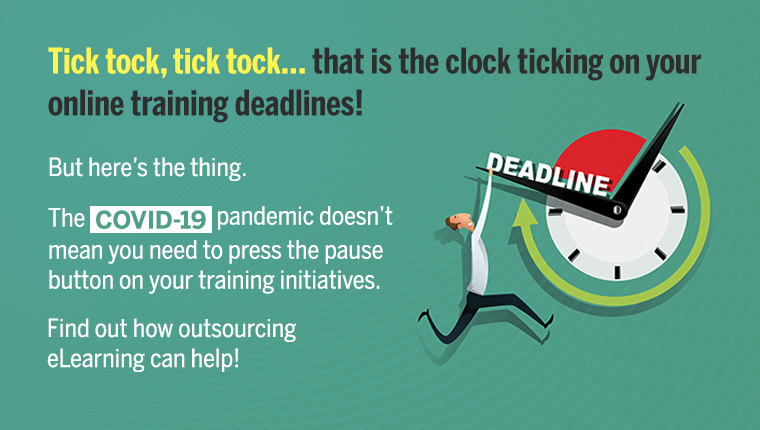The Top 4 Factors to Consider When Outsourcing eLearning

Outsourcing eLearning could be the answer to increasing your organization’s capacity to train their workforce. In a recent poll conducted by Deloitte, more than half the executives said that employee flexibility is one of the most important characteristics in their organization’s ability to handle upheaval. 17% of the managers said that their companies were prepared to adapt and upskill their workforce.
When you outsource your eLearning to a vendor, you can benefit from their skillset as well as release your in-house team to focus on other projects. You can maximize your return on investment by providing high-quality online training content that includes the most up-to-date technological and interactive elements.
Outsourcing eLearning helps companies save money and get the most out of their training budgets. However, if they don’t hire a reliable and competent partner, a lot can be wasted. Companies must carefully outline their criteria for selecting an outsourcing partner in order to ensure its success. Here are a few criteria to consider before choosing an eLearning outsourcing partner.
What are the factors to be considered before outsourcing eLearning?
The top 4 factors that need to be considered before outsourcing eLearning:- Emphasize Cost and Return on Investment
- Get to Know the Team
- Obtain Testimonials from Customers
- Consider Scalability and Size
How to Pick the Right eLearning Course Development Provider
Emphasize Cost and Return on Investment
One of the most important variables to consider before beginning to outsource eLearning is to fix the project’s budget. The cost of designing and developing a course is determined by several factors.
Highly interactive strategies such as game-based modules, watch-try-do eLearning simulations, and branching scenarios, are more expensive to create than videos or simple scenarios. When you make your quotation be sure to include any special requirements that you may have, such as a Learning Management System to host your courses.
You’ll have a better idea of what you should aim for if you begin by comparing vendors. You can evaluate them based on the following parameters:
- Scope of the relationship
- Vendors value additions
- Cost per learning hour (Tip: know what you want from the project)
→ Learn how rapid eLearning can assist you in delivering training at the speed of business need.
2. Get to Know the Team
An eLearning partner will be able to assist you with the technological tools that you need, to create high-quality learning experiences for your staff. If you are located far off, you need to schedule weekly conversations where you discuss your project with the vendor’s dedicated project manager who will be your point of contact. You can also ask for a demo of projects like your own and chat with the vendor’s team to assuage your apprehensions.
Once the vendor begins to develop your courses, you should get to know the development team, instructional designers and project managers that will be working on your project. You need to examine their qualifications and prior projects to get a sense of what they can do. This may be awkward at first, but it gets better with practice.
Make sure that you can work effectively with your vendor and that they have the experience and expertise in instructional design and custom eLearning course development. You can research them on their website based on the following criteria:
- If eLearning course development isn’t their primary source of revenue, then they aren’t a proper match for you.
- How long have they worked in the eLearning sector?
- Their knowledge of eLearning and your core business
- Posts, promotions, views, and comments about them on social media
3. Obtain Testimonials from Customers
The eLearning vendor might show you some of their best work. You need to look at references from their clients to better evaluate them. Check whether their:
- eLearning projects are managed by dedicated teams
- Team has difficulty comprehending your requirements
- Approach to revisions and feedback matches yours
- Ability to operate in differing time zones brings about successful interaction with stakeholders.
- Knowledge of the industry is up to date
- Experience with SMEs (Subject Matter Experts) is on record
4. Consider Scalability and Size
It is not unusual for companies to change things up once in a while. Within the same year, companies may require few brief refresher courses before requiring large-scale eLearning programs for all their remote staff. It might take a long time and a lot of money to hire and train the necessary in-house staff for such a venture.
No matter how big or small they are, when you outsource eLearning, your vendor will have the resources to assign the optimum number of staff to complete your project in time, There are a variety of authoring tools on the market to help you produce eLearning courses, each with its specific advantages and disadvantages. Determine whether your vendor can provide scalability and quality while adhering to your budget and deadlines. The vendor must have a professional team that are proficient in a variety of eLearning authoring tools.
It is critical to evaluate your eLearning vendor’s size and scalability. Make sure you:
- Check whether the vendor can allocate a team.
- Confirm that your provider has the capacity to scale up to suit your growing future needs.
- Look at their eLearning translation experience.
- Confirm that your vendor uses proven project management procedures to ensure the proper management of your online course’s development.
Parting Thoughts!
L&D departments are being held responsible more and more for creating efficient training courses on a limited budget. Outsourcing eLearning design and development can help you save money while at the same time enhancing the quality of your training. This may be a one-stop shop for companies who are having trouble generating eLearning courses in-house.
Check out our free eBook on “A Practical Guide to Outsourcing eLearning Design & Development”. It is a complete guide to all the information that you’ll need to make the best choices. It will also help you determine whether outsourcing eLearning is right for you and how to get the most out of it.




![Pre-Work to Save Time when Outsourcing eLearning [Infographic]](https://blog.commlabindia.com/hubfs/Imported_Blog_Media/elearning-outsourcing-pre-work.jpg)
![6 Steps to Support Your eLearning Outsourcing Partner [Infographic]](https://blog.commlabindia.com/hubfs/Imported_Blog_Media/elearning-outsourcing-tips-support-partner-infographic-v1.jpg)